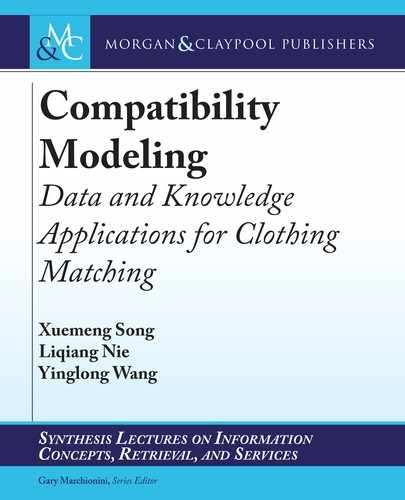48 5. PROTOTYPE-WISE INTERPRETABLE COMPATIBILITY MODELING
Distinguished from these studies, we aim to not only improve the interpretability of the cloth-
ing matching in a comprehensive attribute-wise manner but also facilitate the alternative item
suggestion.
5.2.2 MATRIX FACTORIZATION
As a numerical analysis method, matrix factorization (MF) is widely applied in various re-
search areas, such as the item recommendation [36, 61, 114, 121] and information re-
trieval [79, 97, 113], due to its superior performance in discovering the latent features between
two entities (e.g., the user and item). In order to effectively adapt to different tasks, several
variants of MF have been devised, such as the singular value decomposition (SVD) [17], proba-
bilistic matrix factorization (PMF) [89], and non-negative matrix factorization (NMF) [65], and
their efficiency has been validated in various domains. For example, Sun et al. [111] proposed
a SVDNet to fulfill the retrieval task of person re-identification (reID), where the SVD is em-
ployed to optimize of the deep representation learning process. In addition, Kim et al. [56] pre-
sented a context-aware convolutional matrix factorization (ConvMF) that integrates the CNN
into the PMF in the context of document context-aware recommendation. Besides, as a useful
tool for the sparse and meaningful feature extraction, NMF also drew researchers’ attentions.
For example, Xu et al. [124] proposed a document clustering method based on the NMF with
the term-document matrix. Furthermore, to forecast the fashion styles, Ziad et. al. [139] em-
ployed the NMF to discover the latent clothing styles in an unsupervised manner. Although
the NMF has been successfully applied to solve tasks like text clustering [124], fashion trend-
ing prediction [139], and recommender systems [2], limited efforts have been dedicated to the
complementary clothing matching, which is the major concern of our work.
5.3 METHODOLOGY
In this section, we first formally give the research problem formulation, and then detail the
proposed PAICM.
5.3.1 PROBLEM FORMULATION
In the real-world clothing matching scenarios, users may not only want to know whether
the given fashion items are compatible or not, but also expect to get advice on how to har-
monize the improper outfit. In this context, we aim to devise an attribute-wise interpretable
compatibility modeling scheme to explain the underlying reasons why the given items are in-
compatible in the attribute-wise manner and provide the potential attribute manipulations to
make compatible outfits. Suppose that we have a set of tops T D ft
1
; t
2
; : : : ; t
N
t
g and bottoms
B D fb
1
; b
2
; : : : ; b
N
b
g, where N
t
and N
b
denote the total number of tops and bottoms, respec-
tively. In this work, we characterize each fashion item with a set of attributes (e.g., the color
and category) A D fa
q
g
Q
qD1
, where a
q
is the q-th attribute and Q is the total number of at-
..................Content has been hidden....................
You can't read the all page of ebook, please click here login for view all page.
